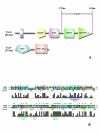Structure-based discovery of inhibitors of the YycG histidine kinase: new chemical leads to combat Staphylococcus epidermidis infections
- PMID: 17094812
- PMCID: PMC1660542
- DOI: 10.1186/1471-2180-6-96
Structure-based discovery of inhibitors of the YycG histidine kinase: new chemical leads to combat Staphylococcus epidermidis infections
Abstract
Background: Coagulase-negative Staphylococcus epidermidis has become a major frequent cause of infections in relation to the use of implanted medical devices. The pathogenicity of S. epidermidis has been attributed to its capacity to form biofilms on surfaces of medical devices, which greatly increases its resistance to many conventional antibiotics and often results in chronic infection. It has an urgent need to design novel antibiotics against staphylococci infections, especially those can kill cells embedded in biofilm.
Results: In this report, a series of novel inhibitors of the histidine kinase (HK) YycG protein of S. epidermidis were discovered first using structure-based virtual screening (SBVS) from a small molecular lead-compound library, followed by experimental validation. Of the 76 candidates derived by SBVS targeting of the homolog model of the YycG HATPase_c domain of S. epidermidis, seven compounds displayed significant activity in inhibiting S. epidermidis growth. Furthermore, five of them displayed bactericidal effects on both planktonic and biofilm cells of S. epidermidis. Except for one, the compounds were found to bind to the YycG protein and to inhibit its auto-phosphorylation in vitro, indicating that they are potential inhibitors of the YycG/YycF two-component system (TCS), which is essential in S. epidermidis. Importantly, all these compounds did not affect the stability of mammalian cells nor hemolytic activities at the concentrations used in our study.
Conclusion: These novel inhibitors of YycG histidine kinase thus are of potential value as leads for developing new antibiotics against infecting staphylococci. The structure-based virtual screening (SBVS) technology can be widely used in screening potential inhibitors of other bacterial TCSs, since it is more rapid and efficacious than traditional screening technology.
Figures









References
-
- Rupp ME, Archer GL. Coagulase-negative staphylococci: pathogens associated with medical progress. Clin Infect Dis. 1994;19:231–243. quiz 244-235. - PubMed
-
- Raad I, Alrahwan A, Rolston K. Staphylococcus epidermidis: emerging resistance and need for alternative agents. Clin Infect Dis. 1998;26:1182–1187. - PubMed
Publication types
MeSH terms
Substances
LinkOut - more resources
Full Text Sources
Other Literature Sources

